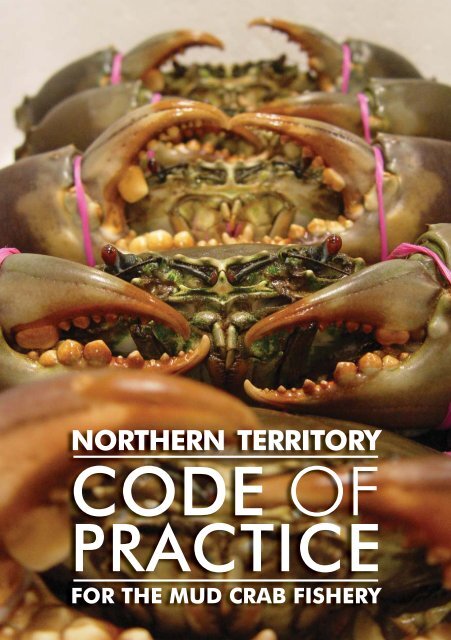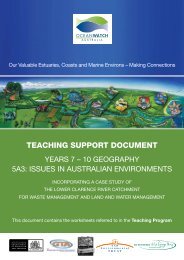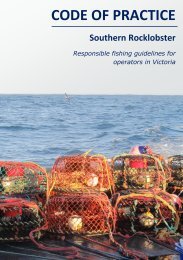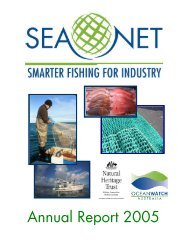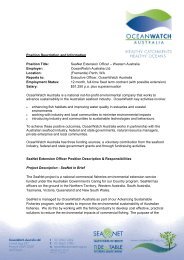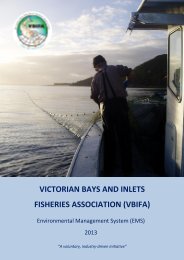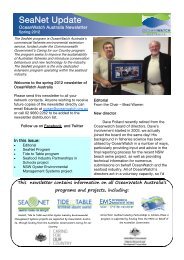NT Code of Practice for the Mud Crab Fishery - OceanWatch Australia
NT Code of Practice for the Mud Crab Fishery - OceanWatch Australia
NT Code of Practice for the Mud Crab Fishery - OceanWatch Australia
You also want an ePaper? Increase the reach of your titles
YUMPU automatically turns print PDFs into web optimized ePapers that Google loves.
NORTHERN TERRITORY<br />
CODE OF<br />
PRACTICE<br />
FOR THE MUD CRAB FISHERY
OBJECTIVE<br />
Every person involved in <strong>the</strong> mud crab fishery<br />
should strive to maximise <strong>the</strong> sustainability,<br />
quality and value <strong>of</strong> <strong>the</strong> catch by only keeping<br />
commercially suitable, quality crabs and<br />
maintaining <strong>the</strong>m in <strong>the</strong> best possible condition<br />
<strong>for</strong> supply to <strong>the</strong> consumer.<br />
ii
MAXIMISE SUSTAINABILITY<br />
The Nor<strong>the</strong>rn Territory mud crab fishery is harvested and managed<br />
sustainably. In <strong>the</strong> interests <strong>of</strong> <strong>the</strong> stock, <strong>the</strong> industry and <strong>the</strong> wider<br />
community, <strong>the</strong> <strong>NT</strong> <strong>Mud</strong> <strong>Crab</strong> Licensee Committee fully supports<br />
continued management <strong>for</strong> <strong>the</strong> production <strong>of</strong> sustainable, quality<br />
<strong>Australia</strong>n seafood.<br />
In 2002 <strong>the</strong> <strong>NT</strong> mud crab fishery was assessed by <strong>the</strong> Commonwealth<br />
Department <strong>of</strong> <strong>the</strong> Environment and Heritage as being ecologically<br />
sustainable <strong>for</strong> export, under <strong>Australia</strong>n Government guidelines based<br />
on <strong>the</strong> Environment Protection and Biodiversity Conservation Act 1999.<br />
In 2007 <strong>the</strong> mud crab fishery was reassessed under <strong>the</strong> guidelines and<br />
accepted <strong>for</strong> fur<strong>the</strong>r export approval.<br />
Maximise value<br />
The value <strong>of</strong> <strong>the</strong> mud crab fishery to both participants and <strong>the</strong> Nor<strong>the</strong>rn<br />
Territory community is maximised when only full, healthy mud crabs are<br />
taken and <strong>the</strong>n cared <strong>for</strong> appropriately. Commercially unsuitable crab, as<br />
described in this <strong>Code</strong> <strong>of</strong> <strong>Practice</strong>, toge<strong>the</strong>r with undersized animals and<br />
berried animals (a female with eggs), must always be returned to <strong>the</strong> water<br />
as soon as possible after being removed from a pot. Maintaining healthy<br />
mud crabs in and out <strong>of</strong> <strong>the</strong> water is <strong>the</strong> key to maximising value.<br />
Maximise quality<br />
A strong, healthy mud crab commands <strong>the</strong> highest price. Ensuring that<br />
mud crabs are handled, transported and stored according to this <strong>Code</strong><br />
<strong>of</strong> <strong>Practice</strong> will maximise a quality product to <strong>the</strong> consumer and help<br />
obtain <strong>the</strong> best price <strong>for</strong> everyone involved – from capture to sale.<br />
iii
FEMALE<br />
Underside view <strong>of</strong> a female<br />
mud crab<br />
Minimum size limit 150 mm<br />
across <strong>the</strong> carapace<br />
Females with eggs must be<br />
released<br />
Female with eggs attached<br />
under <strong>the</strong> abdominal flap –<br />
“berried female”<br />
MALE<br />
Underside view <strong>of</strong> a male<br />
mud crab<br />
Minimum size limit 140 mm<br />
across <strong>the</strong> carapace<br />
iv
CO<strong>NT</strong>E<strong>NT</strong>S<br />
Introduction 1<br />
The <strong>Fishery</strong> 2<br />
During <strong>Crab</strong>bing 3<br />
Commercially Unsuitable <strong>Crab</strong>s (CUC) 5<br />
Storing <strong>Crab</strong>s on <strong>the</strong> Boat 6<br />
Storing <strong>Crab</strong>s at Camp 7<br />
Summary <strong>of</strong> Handling Recommendations <strong>for</strong> Fishers 9<br />
Be<strong>for</strong>e Going <strong>Crab</strong>bing 11<br />
Waste & Pollution 14<br />
Threatened Species 15<br />
The Transport Operation 16<br />
The Trader/Processor Operation 18<br />
Transport Recommendations <strong>for</strong> Shipping to Market 20<br />
Summary <strong>of</strong> Recent Research 21<br />
Recovery Procedure <strong>for</strong> Traders/Processors and Buyers 23<br />
Separate Tank Holding Recommendations <strong>for</strong><br />
Longer Term Storage 25<br />
Contact List 26
I<strong>NT</strong>RODUCTION<br />
In 2001 <strong>the</strong> <strong>Mud</strong> <strong>Crab</strong> <strong>Fishery</strong> was <strong>the</strong> first fishery in <strong>the</strong> Nor<strong>the</strong>rn Territory<br />
to develop a voluntary <strong>Code</strong> <strong>of</strong> <strong>Practice</strong>. Ten years later, recognising <strong>the</strong><br />
need to review <strong>the</strong> code and include new in<strong>for</strong>mation, <strong>the</strong> fishery will also<br />
be <strong>the</strong> first to review and update <strong>the</strong>ir <strong>Code</strong>.<br />
A best-practice guide <strong>for</strong> <strong>the</strong> <strong>Mud</strong> <strong>Crab</strong> <strong>Fishery</strong>, this <strong>Code</strong> <strong>of</strong> <strong>Practice</strong> is<br />
specifically designed to assist operators to maximise <strong>the</strong> quality and value<br />
<strong>of</strong> product, minimise wastage and contribute to <strong>the</strong> ongoing ecological<br />
and economic health <strong>of</strong> <strong>the</strong> <strong>Mud</strong> <strong>Crab</strong> <strong>Fishery</strong> and those businesses that<br />
rely on its sustainability.<br />
The <strong>Code</strong> covers handling, storing, transporting, recovery and tanking<br />
procedures from capture to wholesale operation and provides fishers,<br />
transporters and wholesalers with clear recommendations to ensure <strong>the</strong><br />
post-harvest survival <strong>of</strong> mud crabs along <strong>the</strong> supply chain. The intention<br />
is to maximise revenue <strong>for</strong> those involved in <strong>the</strong> fishery by maintaining<br />
<strong>the</strong> crab in <strong>the</strong> best possible condition from capture to sale. This also<br />
contributes to sustainability by reducing post-harvest mortality, thus<br />
maximising <strong>the</strong> use <strong>of</strong> <strong>the</strong> resource.<br />
The <strong>Code</strong> has been guided by <strong>the</strong> results <strong>of</strong> research undertaken<br />
by Innovative Food Technologies (Primary Industries and Fisheries,<br />
Queensland) in conjunction with <strong>the</strong> <strong>NT</strong> Seafood Council (<strong>NT</strong>SC) and<br />
<strong>the</strong> <strong>NT</strong> <strong>Mud</strong> <strong>Crab</strong> Licensee Committee. The research project Maximising<br />
Revenue Within <strong>the</strong> <strong>NT</strong> <strong>Mud</strong> <strong>Crab</strong> <strong>Fishery</strong> by Enhancing <strong>the</strong> Post-Harvest<br />
Survival <strong>of</strong> <strong>Mud</strong> <strong>Crab</strong>s was funded by <strong>the</strong> Fisheries Research and<br />
Development Corporation (FRDC).<br />
This voluntary <strong>Code</strong> <strong>of</strong> <strong>Practice</strong> has been developed by <strong>the</strong> <strong>NT</strong> <strong>Mud</strong> <strong>Crab</strong><br />
Licensee Committee <strong>of</strong> <strong>the</strong> <strong>NT</strong>SC, with assistance from <strong>OceanWatch</strong><br />
<strong>Australia</strong>’s SeaNet Program and Innovative Food Technologies,<br />
Department <strong>of</strong> Employment, Economic Development and Innovation<br />
(DEEDI), Queensland. Financial support has been provided by DEEDI and<br />
<strong>the</strong> FRDC.<br />
1
THE FISHERY<br />
The Nor<strong>the</strong>rn Territory <strong>Mud</strong> <strong>Crab</strong> <strong>Fishery</strong> operates in tidal waters between<br />
<strong>the</strong> Western <strong>Australia</strong>n and Queensland borders, with most activity<br />
concentrated in <strong>the</strong> Gulf <strong>of</strong> Carpentaria. Commercial crabbing is not<br />
permitted in Darwin Harbour and in most creeks adjoining Shoal Bay,<br />
Leaders Creek and <strong>the</strong> waterways <strong>of</strong> Kakadu National Park.<br />
Many commercial fishers work from remote locations under difficult<br />
environmental conditions and limited, if any, infrastructure. <strong>Crab</strong> pots<br />
are baited with fresh meat or fish and set in estuarine or coastal waters.<br />
The majority <strong>of</strong> crab fishers work from 5 to 6.2 metre outboard powered<br />
dinghies and have semi-permanent land-based camps where <strong>the</strong> crabs<br />
are stored prior to transport to Darwin.<br />
<strong>Crab</strong>s are transported to Darwin by road in temperature controlled trucks,<br />
usually inside crates lined and covered with damp hessian bags. At <strong>the</strong><br />
trader/processor premises <strong>the</strong> crabs are repacked in waxed cardboard<br />
or foam boxes <strong>for</strong> shipment interstate or to export markets.<br />
The supply chain from harvest to market <strong>for</strong> mud crabs in <strong>the</strong> <strong>NT</strong> can be<br />
up to 15 days. The physical demands on <strong>the</strong> crab are extreme as <strong>the</strong>y are<br />
transported and distributed by road and air.<br />
Mortality rates <strong>of</strong> mud crab can be minimised through development <strong>of</strong><br />
appropriate, practical and cost-effective handling procedures along <strong>the</strong><br />
harvest-to-market supply chain.<br />
The <strong>Mud</strong> <strong>Crab</strong> <strong>Fishery</strong> is a valuable fishery in <strong>the</strong> <strong>NT</strong> and <strong>the</strong> sustainable<br />
use <strong>of</strong> <strong>the</strong> resource is supported by both industry and government.<br />
A highly regarded fishery aims to maintain a top quality<br />
product while operating in an environmentally responsible<br />
way in all its activities.<br />
2
DURING CRABBING<br />
Clear pots at least once every 24 hours<br />
Don’t allow crab pots to dry out or be left in hot, shallow water – sun and<br />
hot water can stress <strong>the</strong> crab. Stress makes <strong>the</strong> crab more likely to die or<br />
to reach market in poor condition.<br />
One <strong>of</strong> <strong>the</strong> biggest causes <strong>of</strong> crab deaths is when hot water comes in over<br />
<strong>the</strong> mud flats on <strong>the</strong> incoming tide.<br />
Haul pots in a steady, continuous motion<br />
Steadily hauling pots and placing <strong>the</strong>m gently in <strong>the</strong> boat will avoid<br />
physical damage and stress to crabs.<br />
Remove crabs from pots gently<br />
Open <strong>the</strong> pot door and let <strong>the</strong> crabs slide out. Don’t shake <strong>the</strong>m out as<br />
this causes physical damage and stress.<br />
<strong>Crab</strong>s must be sorted and tied as soon as possible<br />
after being removed from pots<br />
Carefully return berried females, undersized animals, and commercially<br />
unsuitable crabs (CUC) to <strong>the</strong> water as soon as you can after being<br />
removed from a pot. The crab <strong>the</strong>n has more chance <strong>of</strong> surviving to<br />
reproduce or grow to a legal size.<br />
Newly moulted crabs are easily stressed and can’t handle transport<br />
and temperature changes.<br />
<strong>Crab</strong>s kept <strong>for</strong> market must be tied as soon as possible. If <strong>the</strong> wea<strong>the</strong>r is bad, tie<br />
<strong>the</strong> crabs in <strong>the</strong> nearest calm water. They must not be returned to camp untied.<br />
Tying a crab is a legal obligation<br />
Tie <strong>the</strong> crab’s claws hard against <strong>the</strong> body to restrict movement. This will<br />
minimise <strong>the</strong> crab’s stress, aggression and <strong>the</strong> possibility <strong>of</strong> damage to<br />
o<strong>the</strong>r crabs and handlers.<br />
3
A well tied crab should have<br />
its mouth clear <strong>of</strong> string, its<br />
claws firmly restricted and<br />
<strong>the</strong> string cut no more than<br />
30 mm from <strong>the</strong> knot. Too<br />
much string looks bad when<br />
<strong>the</strong> crab gets to market,<br />
can get caught around legs<br />
leading to leg loss and can<br />
break loose and clog up<br />
holding tanks.<br />
String ends should be kept on <strong>the</strong> boat and appropriately disposed <strong>of</strong> at<br />
camp.<br />
Always handle crabs gently<br />
A carefully handled crab has a much higher chance <strong>of</strong> survival, whe<strong>the</strong>r it<br />
is being returned to <strong>the</strong> water or kept <strong>for</strong> market.<br />
By-catch<br />
While by-catch in <strong>the</strong> fishery is very low, all attempts should be made to<br />
quickly release non-retained animals alive with <strong>the</strong> minimum <strong>of</strong> stress and<br />
injury.<br />
4
COMMERCIALLY UNSUITABLE CRABS (CUC)<br />
Male (Buck)<br />
A commercially unsuitable<br />
male is one whose underside<br />
opposite <strong>the</strong> middle leg<br />
(marked with an X on <strong>the</strong><br />
diagram) can be depressed.<br />
CUCs must be returned to <strong>the</strong><br />
water unharmed.<br />
Female (Jenny)<br />
A commercially unsuitable<br />
female is one which makes<br />
an audible clicking sound<br />
when both <strong>for</strong>ward quadrants<br />
(see diagram) <strong>of</strong> <strong>the</strong> shell<br />
(carapace) are pressed. CUCs<br />
must be returned to <strong>the</strong> water<br />
unharmed.<br />
There are only two to three weeks between a commercially unsuitable and<br />
a full, healthy crab once it is returned to <strong>the</strong> water.<br />
5
STORING CRABS ON THE BOAT<br />
Avoid breeze and sunlight<br />
Hold crabs in clean, damp, insect-pro<strong>of</strong>, hessian-lined and covered crates<br />
to limit disturbance, minimise moisture loss and stop breeze and sunlight<br />
affecting <strong>the</strong> crabs.<br />
Exposure to sun and wind will dehydrate a crab, lower its body weight and<br />
value and possibly lead to its death.<br />
Water<br />
<strong>Crab</strong>s can die from contamination by polluted water and contact with<br />
fuel. They should not be stored in <strong>the</strong> bilge compartment as it may have<br />
spilt fuel in it. Dual decks can avoid this problem.<br />
Use only clean water to maintain crab safety and quality. Seawater from<br />
polluted waters must not be used on surfaces or containers containing<br />
crabs.<br />
Keep quiet and disturb as little as possible<br />
Limit any loud noises, vibration and impacts as <strong>the</strong>se will cause increased<br />
stress levels in <strong>the</strong> crab. Avoid disturbing <strong>the</strong> crabs – each time you disturb<br />
<strong>the</strong> crabs you are increasing stress levels. Disturbance includes physical<br />
movement in rough wea<strong>the</strong>r or during road transport.<br />
Handle gently<br />
Minimise <strong>the</strong> handling<br />
movements and be careful<br />
when legs are stuck in baskets<br />
or caught on ano<strong>the</strong>r crab.<br />
Pulling on a leg that is stuck<br />
can cause bleeding and lead<br />
to crab deaths.<br />
6
STORING CRABS AT CAMP<br />
Provide a stress-free environment<br />
As with storing crabs on <strong>the</strong> boat, avoid breeze, sunlight, and contaminated<br />
water and minimise noise, disturbances and handling.<br />
Store crabs out <strong>of</strong> direct sunlight in a cool, moist, wind pro<strong>of</strong> and insect<br />
and vermin pro<strong>of</strong> shelter. In a camp, this is best done with crates raised<br />
<strong>of</strong>f <strong>the</strong> ground and with a pump and sprinkler system to keep conditions<br />
cool and moist.<br />
The best storage area sheds are those constructed with double lined shade<br />
cloth on all sides and doors, and with a ro<strong>of</strong> which is sun pro<strong>of</strong>.<br />
Packing<br />
Hessian sacking should be double<br />
folded to keep flies out and to<br />
maintain a humid environment.<br />
Crates should not be overfilled<br />
as this can lead to crabs in some<br />
crates being crushed if o<strong>the</strong>r crates<br />
are stacked on top. Packaging<br />
used <strong>for</strong> crabs must be stored in a<br />
clean environment.<br />
7
Keep temperature constant<br />
Temperature fluctuations can be simply avoided by keeping <strong>the</strong> hessian<br />
damp at all times. Avoid large or sudden fluctuations (>10°C) <strong>of</strong> holding<br />
temperatures as sudden changes will cause stress.<br />
Allow crabs to slowly get used<br />
to new temperatures and hold<br />
around 18ºC to 25ºC – no more<br />
than 10°C below <strong>the</strong>ir normal<br />
environmental temperature.<br />
Damp hessian will cool <strong>the</strong><br />
temperature inside a crate <strong>of</strong><br />
crabs by up to 5ºC, so don’t<br />
dampen on cool, dry season<br />
evenings.<br />
Stored crabs should be checked regularly and<br />
weak or dead crabs removed<br />
Remove weak, slow or bleeding crabs. These crabs have been stressed at<br />
some stage and <strong>the</strong>y may benefit from a recovery step (see later section).<br />
Dead crabs must be removed as <strong>the</strong>ir presence is harmful to adjacent<br />
live crabs. Best practice is to bury, burn, or dispose <strong>of</strong> dead crabs in deep<br />
water once <strong>the</strong> string ties have been removed.<br />
By removing dead crabs, insects<br />
and vermin are less likely to be<br />
attracted to <strong>the</strong> storage area.<br />
It also removes a bacterial<br />
contamination source, which can<br />
infect healthy crabs.<br />
Bury any contaminated, badly<br />
damaged, de<strong>for</strong>med, diseased or<br />
parasitic (loxi) crab.<br />
8
SUMMARY OF HANDLING<br />
RECOMMENDATIONS FOR FISHERS<br />
• Confirm legal size and not berried as per regulations<br />
• Confirm <strong>the</strong> crab is not a commercially unsuitable crab (CUC).<br />
Newly moulted crabs are prone to stress and will not tolerate<br />
transport and temperature changes. CUCs returned to <strong>the</strong> water<br />
will become “A” grade crabs within weeks<br />
• Bury or dispose <strong>of</strong> responsibly any contaminated, badly damaged,<br />
de<strong>for</strong>med, diseased or parasitic (loxi) crab<br />
• Tie crab’s claws hard against <strong>the</strong> body to restrict movement as soon<br />
as possible. This will minimise <strong>the</strong> crab’s stress, aggression and <strong>the</strong><br />
possibility <strong>of</strong> damage to o<strong>the</strong>r crabs and handlers<br />
• Hold in clean, damp, insect pro<strong>of</strong>, hessian-lined and covered<br />
crates to limit <strong>the</strong> disturbance, minimise moisture loss and stop<br />
direct breeze and sunlight affecting <strong>the</strong> crabs<br />
• Avoid direct wind/breeze. Holding crabs in drafts during transport<br />
and storage will cause mortalities. Air-conditioning will also dry<br />
crabs out, but may be required to avoid very high temperatures<br />
• Keep quiet. Limit any loud noises, vibration and impacts as <strong>the</strong>se<br />
will cause increased stress levels in <strong>the</strong> crab<br />
• Disturb as little as possible. Each time you disturb <strong>the</strong> crab you are<br />
increasing stress levels in <strong>the</strong> crab<br />
• Handle gently. Minimise <strong>the</strong> handling movements and be careful<br />
when legs are stuck in baskets or caught on ano<strong>the</strong>r crab. Pulling<br />
on a leg that is stuck can cause bleeding and increases <strong>the</strong> risk<br />
<strong>of</strong> mortality<br />
9
• Keep temperature constant. Avoid large or sudden fluctuations<br />
(>10°C) <strong>of</strong> holding temperatures as sudden changes will cause<br />
stress. Allow crabs to slowly acclimatize to new temperatures and<br />
hold around 18ºC to 25ºC<br />
• Remove weak, slow or bleeding crabs. These crabs have been<br />
compromised at some stage and may be included in a purge/<br />
recovery step to help revive <strong>the</strong>m but must be closely monitored<br />
• Dead crabs must be destroyed/dumped. Even a recently dead crab<br />
is inedible and can be a health risk to adjacent live crabs<br />
• All crabs held out <strong>of</strong> <strong>the</strong> water <strong>for</strong> more than 5 days would benefit<br />
from a recovery step (see later section)<br />
10
BEFORE GOING CRABBING<br />
Make sure your boat and motor are in good<br />
working order and regularly maintained<br />
Fishing can be a dangerous occupation. Make sure boats and motors<br />
are always in good working order. Safety at sea is <strong>the</strong> first rule <strong>of</strong> a<br />
fishing operation.<br />
Good boat design and maintenance also minimise <strong>the</strong> chance <strong>of</strong><br />
contamination and physical damage to <strong>the</strong> crabs.<br />
It is a legal requirement to have all <strong>the</strong> relevant safety gear on your fishing<br />
boat. If you are unsure, contact <strong>the</strong> <strong>NT</strong> Marine Safety Branch <strong>for</strong> manning<br />
requirements, safety equipment and boat buoyancy requirements.<br />
Occupational health and safety<br />
It is important that clear occupational health and safety guidelines are in<br />
place <strong>for</strong> <strong>the</strong> entire fishing operation and those involved clearly understand<br />
<strong>the</strong>se and o<strong>the</strong>r relevant food safety and regulatory obligations.<br />
When those involved in <strong>the</strong> fishery understand <strong>the</strong>ir responsibilities during<br />
fishing operations <strong>the</strong> chances <strong>of</strong> accidents are minimised.<br />
Hygienic handling<br />
Those involved in <strong>the</strong> fishery must comply with regulations relating to <strong>the</strong><br />
hygienic handling <strong>of</strong> food products, such as mud crabs.<br />
Any person with a contagious or notifiable illness must not be allowed<br />
to come in contact with crabs unless <strong>the</strong> integrity <strong>of</strong> <strong>the</strong> product can be<br />
guaranteed.<br />
Smoking, eating and drinking should be prohibited in sorting and<br />
storage areas.<br />
11
Secure harmful materials<br />
Harmful and poisonous materials such as oils, insecticides and cleaning<br />
products must be stored and/or secured in an area where <strong>the</strong>y cannot<br />
contaminate crabs or storage areas.<br />
Never discard chemicals, fuel, oil or o<strong>the</strong>r non-environmentally friendly<br />
products in <strong>the</strong> water or in <strong>the</strong> bush – this is not only illegal but can have<br />
long term detrimental effects on crab and o<strong>the</strong>r marine species, as well as<br />
<strong>the</strong> environment generally.<br />
Pest control<br />
Rodents, birds and insects are all potential carriers <strong>of</strong> diseases which<br />
could contaminate crabs and it is important that adequate steps are taken<br />
to control pests on a boat and in storage areas. Domestic animals should<br />
not be kept on board.<br />
Environmental and camp hygiene are essential <strong>for</strong><br />
a continuing healthy fishery<br />
Deck, mats, crab pots, holding containers and o<strong>the</strong>r potential crab contact<br />
surfaces should be clean to prevent any contamination.<br />
The boat should be<br />
thoroughly cleaned be<strong>for</strong>e<br />
(and kept clean during)<br />
each fishing trip to remove<br />
any contaminants that may<br />
be present.<br />
Ensure only “food safe”<br />
cleaning and sanitising<br />
products are used and<br />
always follow manufacturer’s<br />
directions when using <strong>the</strong>m.<br />
12
Make sure you are familiar with and comply with<br />
<strong>the</strong> legislation that governs <strong>the</strong> management <strong>of</strong><br />
<strong>the</strong> mud crab fishery<br />
This <strong>Code</strong> <strong>of</strong> <strong>Practice</strong> is a guide only and doesn’t remove your obligation<br />
to understand and comply with <strong>the</strong> legislation.<br />
The legislation that governs <strong>the</strong> management <strong>of</strong> <strong>the</strong> mud crab fishery is<br />
a result <strong>of</strong> industry and government consultation over many years. It is<br />
<strong>the</strong>re to ensure <strong>the</strong> continuing sustainability <strong>of</strong> <strong>the</strong> stocks that, in turn, our<br />
industry depends upon <strong>for</strong> our continuing viability. Copies <strong>of</strong> <strong>the</strong> <strong>Mud</strong><br />
<strong>Crab</strong> <strong>Fishery</strong> Management Plan are available to download at www.ntsc.<br />
com.au/legislation.html<br />
Overpotting is not only illegal, it affects <strong>the</strong><br />
continuing viability <strong>of</strong> all who have investments in<br />
our fishery<br />
The Licensee Committee has supported significant penalties in<br />
Fisheries legislation on those operators who use more than <strong>the</strong> pots<br />
<strong>the</strong>y are allowed.<br />
The Licensee Committee will not provide any support to those who overpot.<br />
Respect <strong>the</strong> laws governing Aboriginal land<br />
Aboriginal land in <strong>the</strong> Nor<strong>the</strong>rn Territory is held as inalienable freehold<br />
title. Permits from <strong>the</strong> appropriate Aboriginal Land Council are required<br />
be<strong>for</strong>e entering on to this land.<br />
When in <strong>the</strong> vicinity <strong>of</strong> an Aboriginal community, work should be conducted<br />
in a manner that is respectful <strong>of</strong> <strong>the</strong> community.<br />
13
WASTE & POLLUTION<br />
Pollution <strong>of</strong> <strong>the</strong> marine environment is strictly<br />
controlled by law and penalties <strong>for</strong> not<br />
complying are large<br />
Plastics are not allowed to be discharged into <strong>the</strong> sea. All plastics must be<br />
kept on <strong>the</strong> boat and disposed <strong>of</strong> at appropriate facilities. Plastic waste<br />
which <strong>for</strong>ms a continuous loop, such as bait bands, should be cut on<br />
board to minimise impacts in case it is accidentally lost at sea.<br />
The discharge <strong>of</strong> noxious and hazardous liquids that are harmful to <strong>the</strong><br />
aquatic environment are prohibited by law.<br />
The law does not permit <strong>the</strong> disposal <strong>of</strong> non-plastic garbage, including<br />
food waste and string ends, within <strong>the</strong> area <strong>of</strong> <strong>the</strong> fishery.<br />
The law does not allow oils or oily mixtures to be discharged into <strong>the</strong> sea.<br />
Waste oil and oily residues must be stored <strong>for</strong> disposal at appropriate<br />
waste disposal facilities.<br />
Lost fishing gear and garbage can pose a significant threat to aquatic life.<br />
All ef<strong>for</strong>ts should be made to retrieve lost fishing gear. If it is not possible<br />
to collect, report <strong>the</strong> location <strong>of</strong> <strong>the</strong> gear to <strong>the</strong> relevant authorities.<br />
Ef<strong>for</strong>ts should also be made to retrieve any non-degradable garbage<br />
or wastes found during fishing operations, <strong>for</strong> proper disposal at<br />
onshore facilities.<br />
Any oil or chemical spills or o<strong>the</strong>r incidences <strong>of</strong> environmental<br />
damage in <strong>the</strong> area <strong>of</strong> <strong>the</strong> fishery should be reported to <strong>the</strong> Pollution<br />
Hotline 1800 064 567.<br />
14
THREATENED SPECIES<br />
There are a number <strong>of</strong> species listed as protected under <strong>the</strong><br />
Commonwealth Environment Protection and Biodiversity Conservation<br />
Act 1999 and under <strong>the</strong> Nor<strong>the</strong>rn Territory’s Territory Parks and Wildlife<br />
Conservation Act.<br />
All interactions with protected species must be recorded in your logbook.<br />
Interactions can also be reported to Marine WildWatch.<br />
Under <strong>the</strong> EPBC Act it is not an <strong>of</strong>fence to interact with a protected species<br />
when conducting your regular fishing operations, even if <strong>the</strong> interaction<br />
results in <strong>the</strong> animal’s death. However, it is an <strong>of</strong>fence to not report an<br />
interaction with a protected species. Record <strong>the</strong> date <strong>of</strong> interaction, species<br />
involved, number <strong>of</strong> animals, approximate length, location, gear or bait<br />
used and whe<strong>the</strong>r <strong>the</strong> animal was released alive or dead.<br />
Some examples <strong>of</strong> interactions that require reporting are:<br />
• Any action resulting in <strong>the</strong> killing or injuring <strong>of</strong> a listed species<br />
• The accidental capture <strong>of</strong> a listed species in a fishing operation<br />
• A humane action that is necessary to relieve or prevent <strong>the</strong> suffering <strong>of</strong><br />
a listed species<br />
• An action taken to prevent<br />
risk to human health<br />
• An action that is necessary<br />
to deal with an emergency<br />
where <strong>the</strong>re is a serious<br />
threat to human life or<br />
property<br />
Protected species include<br />
marine turtles, crocodiles,<br />
dugong, dolphins and<br />
sawfish.<br />
15
THE TRANSPORT OPERATION<br />
The role <strong>of</strong> <strong>the</strong> transport driver is crucial in<br />
ensuring crabs arrive at <strong>the</strong>ir destination in <strong>the</strong><br />
best possible condition<br />
Drivers should ensure <strong>the</strong>y have permission to enter or cross Aboriginal<br />
land or private property and observe any restrictions that might apply,<br />
such as being in possession <strong>of</strong> alcohol.<br />
A significant percentage <strong>of</strong> crab deaths occur during long distance<br />
transport by road to Darwin.<br />
Vehicles should be properly maintained, cooling units regularly serviced and<br />
cargo areas kept clean and cool during transport <strong>of</strong> crabs.<br />
Cargo areas should be shielded from <strong>the</strong> sun and wind, be free from fuel<br />
and exhaust odours, allow airflow around crates and have mechanisms to<br />
secure crates in place during transport.<br />
For journeys longer than 3 hours a cooling system that keeps transport<br />
area at 18ºC to 25ºC will minimise stress in <strong>the</strong> crabs.<br />
Healthy, full crabs that are loaded on a vehicle will handle a journey <strong>of</strong><br />
many hours on <strong>the</strong> road if <strong>the</strong> vehicle transporting <strong>the</strong>m is fitted with <strong>the</strong>se<br />
basic but very necessary requirements.<br />
Drivers should ensure<br />
that only live crabs are<br />
loaded into trucks<br />
While it is <strong>the</strong> fishing operator’s<br />
responsibility to provide only<br />
healthy crab, it is also <strong>the</strong> driver’s<br />
responsibility to make sure that<br />
crates loaded on a truck do not<br />
obviously contain dead crabs or<br />
crabs infected by insects.<br />
16
Crates should not be overfilled as this can lead to<br />
crabs in some crates being crushed if o<strong>the</strong>r crates<br />
are stacked on top.<br />
An alert nose and pair <strong>of</strong> eyes can mean <strong>the</strong> difference between a healthy<br />
cargo delivered safely and a cargo that has unnecessary deaths and<br />
reduced quality that costs everyone financially.<br />
Ensure that crates are suitably moist and<br />
appropriately stacked <strong>for</strong> transport <strong>for</strong> both short<br />
and long distances<br />
Wet hessian bags be<strong>for</strong>e loading<br />
crates onto a truck. Securely fasten<br />
crates so <strong>the</strong>y cannot move during<br />
transport. The <strong>for</strong>ward cargo area<br />
provides a gentler ride.<br />
Remember, gently handled<br />
crabs have a greater chance <strong>of</strong><br />
reaching <strong>the</strong> consumer in <strong>the</strong><br />
best possible condition.<br />
Be aware that o<strong>the</strong>r people use boat ramps and<br />
conduct loading <strong>of</strong> trucks accordingly<br />
Be aware <strong>of</strong> <strong>the</strong> rights <strong>of</strong> o<strong>the</strong>rs at boat ramps and ensure that access to<br />
<strong>the</strong>m is not denied because <strong>of</strong> <strong>the</strong> truck loading operation. Avoiding conflict<br />
with o<strong>the</strong>r user groups is important in ensuring continued access to <strong>the</strong><br />
resource and support from <strong>the</strong> general public.<br />
Do not leave rubbish or rejected crabs at boat ramps. The Licensee<br />
Committee will not provide any support to those who behave in<br />
such a manner.<br />
17
THE TRADER/PROCESSOR OPERATION<br />
The trader/processor is <strong>the</strong> final quality control point be<strong>for</strong>e mud crabs<br />
reach <strong>the</strong> buyers. As such, <strong>the</strong> trader/processor can have a major impact<br />
on prices received back through <strong>the</strong> chain to <strong>the</strong> fishing operation.<br />
Sorting, packing and storage rooms on trader/<br />
processor premises must comply with all health<br />
regulations and be clean, sun pro<strong>of</strong>, wind pro<strong>of</strong>,<br />
insect and vermin pro<strong>of</strong><br />
The care taken in <strong>the</strong> fishing and transport operations can be severely<br />
compromised if <strong>the</strong> trader/processor’s premises are less than satisfactory.<br />
With <strong>the</strong> introduction <strong>of</strong> tough food safety laws, sub standard premises<br />
could mean <strong>the</strong> loss <strong>of</strong> a licence to handle crabs as a trader/processor.<br />
Check and record temperature <strong>of</strong> <strong>the</strong> truck cargo<br />
area be<strong>for</strong>e unloading<br />
The temperature <strong>of</strong> <strong>the</strong> cargo area <strong>of</strong> a truck at <strong>the</strong> premises is a<br />
critical point in <strong>the</strong> process <strong>of</strong> transporting crabs from point <strong>of</strong> capture<br />
to point <strong>of</strong> sale.<br />
Unacceptably high or low temperatures at this point can cause a significant<br />
deterioration in crab quality between here and <strong>the</strong> market.<br />
Both <strong>the</strong> transport operator and <strong>the</strong> fisher should be advised <strong>of</strong> any<br />
abnormal temperatures recorded as a matter <strong>of</strong> priority.<br />
Unloading <strong>of</strong> trucks should be conducted as soon<br />
as possible with as little disturbance as possible<br />
As <strong>the</strong> crab has been out <strong>of</strong> <strong>the</strong> water <strong>for</strong> some time, <strong>the</strong> gentle handling<br />
<strong>of</strong> crab at this point is crucial in maintaining quality and <strong>the</strong>re<strong>for</strong>e value.<br />
18
<strong>Crab</strong>s should be sorted and graded <strong>for</strong> market<br />
as soon as possible after being received by <strong>the</strong><br />
trader/processor<br />
Any crabs that are dead, slow or damaged should be separated out<br />
accordingly.<br />
This will ensure that healthy crabs have <strong>the</strong> greatest chance <strong>of</strong> reaching<br />
<strong>the</strong> consumer in a healthy state.<br />
Dead crabs should be double bagged if <strong>the</strong>y are to be disposed <strong>of</strong> at a<br />
Council dump.<br />
Maintain crabs in approved boxes at 18ºC to 25ºC<br />
until delivery to airport or local market<br />
The temperature range <strong>of</strong> 18ºC to 25ºC is <strong>the</strong> optimum to ensure that<br />
live mud crabs have <strong>the</strong> best chance to reach <strong>the</strong> consumer in premium<br />
marketable condition. A healthy crab packed in an appropriate box and<br />
kept at this temperature will provide <strong>the</strong> best financial return to all sectors<br />
<strong>of</strong> <strong>the</strong> industry.<br />
<strong>Crab</strong>s should be delivered to <strong>the</strong> airport as close to flight departure time<br />
as possible in a vehicle that has a covered cargo area. Best results are<br />
achieved if an air-conditioned vehicle is used.<br />
Ensure that clean, dry crates and hessian bags are<br />
provided to <strong>the</strong> transport driver <strong>for</strong> delivery back<br />
to <strong>the</strong> fishing operation<br />
The maintenance <strong>of</strong> quality control throughout <strong>the</strong> chain from harvest to<br />
<strong>the</strong> consumer is crucial to <strong>the</strong> continued economic and ecological health<br />
<strong>of</strong> <strong>the</strong> mud crab fishery.<br />
Communication and cooperation between sectors is vital to ensure this.<br />
19
TRANSPORT RECOMMENDATIONS<br />
FOR SHIPPING TO MARKET<br />
• Cool crabs to 18ºC to 25ºC if possible prior to packaging<br />
• Provide air holes in packaging container<br />
• Line bottom <strong>of</strong> container with damp, old newspaper (fresh newsprint<br />
can be toxic)<br />
• For middle and top layers use dry, old newspaper (damp newspaper<br />
smo<strong>the</strong>rs <strong>the</strong>m)<br />
• Place very large crabs on bottom layer<br />
• Minimise rough handling and vibration during transport<br />
• Provide traceability <strong>of</strong> product if possible – state <strong>of</strong> origin at least<br />
• Mark containers as “live product, fragile, this way up, keep cool but<br />
not refrigerated<br />
20
SUMMARY OF RECE<strong>NT</strong> RESEARCH<br />
High mortality rates <strong>of</strong> mud crab can be minimised through development<br />
<strong>of</strong> appropriate, practical and cost-effective handling procedures along<br />
<strong>the</strong> harvest-to-market supply chain.<br />
Research undertaken by Innovative Food Technologies, Department <strong>of</strong><br />
Employment, Economic Development and Innovation (DEEDI, QLD)<br />
looked at how to enhance <strong>the</strong> post-harvest survival <strong>of</strong> mud crabs along<br />
<strong>the</strong> supply chain.<br />
The research was able to identify which handling steps along <strong>the</strong> chain<br />
impose <strong>the</strong> greatest stress to crabs. With this in<strong>for</strong>mation, alternative<br />
handling practices were developed to minimise stress and improve survival<br />
rates.<br />
Feedback from harvesters, trader/<br />
processors and <strong>the</strong> retail sector has<br />
indicated increased survival and improved<br />
vigour <strong>of</strong> mud crabs when <strong>the</strong> alternative<br />
handling methods have been employed.<br />
Industry has reported a 50% reduction<br />
in mortalities in <strong>the</strong> processing sector<br />
and a fur<strong>the</strong>r 10% reduction at retail<br />
level. <strong>Mud</strong> crabs reach <strong>the</strong> consuming<br />
public in premium quality, raising public<br />
confidence in <strong>the</strong> product and improving<br />
public perception <strong>of</strong> <strong>the</strong> commercial<br />
operators.<br />
Increased survival <strong>of</strong> <strong>the</strong> crabs within<br />
this fishery not only improves resource<br />
sustainability, but also improves public<br />
perception <strong>of</strong> commercial activities<br />
within <strong>the</strong> mud crab fishery.<br />
21
The research found that <strong>the</strong> major causes <strong>of</strong> stress include emersion<br />
(holding crabs out <strong>of</strong> water), handling disturbance and temperature<br />
changes. When mud crabs are out <strong>of</strong> water, but held quietly, undisturbed<br />
and in a moist environment, stress levels are low.<br />
Dehydration is a significant factor as <strong>the</strong> consequent water loss from <strong>the</strong><br />
crabs reduces <strong>the</strong> total weight <strong>of</strong> a crab. This has implications <strong>for</strong> all<br />
sectors <strong>of</strong> <strong>the</strong> industry with respect to revenue return.<br />
<strong>Mud</strong> crabs are handled frequently at different points during <strong>the</strong> supply<br />
chain. Each handling event involves physical movement <strong>of</strong> <strong>the</strong> crabs and<br />
<strong>of</strong>ten a degree <strong>of</strong> shock, with all such disturbances adding stress to <strong>the</strong><br />
crabs. If carried out gently and with care, <strong>the</strong> physical disturbance only<br />
imposes temporary stress on <strong>the</strong> crabs, from which <strong>the</strong>y recover quickly.<br />
Grading and loading/unloading <strong>for</strong> transport involves greater physical<br />
movement and was found to be stressful to <strong>the</strong> crabs. A particular stress factor<br />
was exposure <strong>of</strong> <strong>the</strong> crabs to breeze. This caused very high stress levels and<br />
resulted in a high proportion <strong>of</strong> mortalities.<br />
Holding crabs at an appropriate temperature and limiting temperature<br />
change is optimal <strong>for</strong> minimising stress. Sudden variations in temperature<br />
within <strong>the</strong> supply chain are common and <strong>the</strong> damp hessian used during<br />
storage and transport is not always effective in moderating <strong>the</strong>se changes.<br />
The research concluded that mud crabs best tolerate a temperature range<br />
between 18ºC to 25ºC.<br />
The major recommendation from <strong>the</strong> research is <strong>the</strong> inclusion <strong>of</strong> a recovery<br />
step within <strong>the</strong> distribution chain <strong>for</strong> live mud crab. It is important to include<br />
a purge step <strong>of</strong> 2-3 hours where <strong>the</strong> crabs are returned to aerated water<br />
to allow excretion <strong>of</strong> accumulated ammonia. The crabs can <strong>the</strong>n be held<br />
in fresh seawater tanks to fully recover.<br />
A copy <strong>of</strong> <strong>the</strong> full report can be obtained from John Mayze or<br />
Sue Poole. Please contact john.mayze@deedi.qld.gov.au or<br />
sue.poole@deedi.qld.gov.au<br />
22
RECOVERY PROCEDURE FOR TRADERS/<br />
PROCESSORS AND BUYERS<br />
Prior to re-immersion<br />
• <strong>Crab</strong>s and water should be about <strong>the</strong> same temperature be<strong>for</strong>e reimmersion<br />
• Sort <strong>the</strong> crabs – badly damaged, very slow or frothing crabs should<br />
be killed and cooked as <strong>the</strong>y are unlikely to survive additional stress<br />
from fur<strong>the</strong>r transportation<br />
• Isolate damaged or bleeding crabs, as blood in <strong>the</strong> water will<br />
increase inter-animal aggression<br />
• Gently clean/rinse crabs <strong>of</strong> excessive mud, faeces or contaminates<br />
• Ensure crabs are well-tied so <strong>the</strong>y can’t work <strong>the</strong>ir claws loose<br />
Recovery stage (re-immersion) parameters<br />
• Fresh, clean seawater, bore water, town water or rain water<br />
around 25ºC<br />
• 1:10 live crab weight (kg) to litre <strong>of</strong> water i.e. 1 kg crab to<br />
10 litres <strong>of</strong> water<br />
• Aeration is essential – without fine bubble aeration <strong>of</strong> <strong>the</strong> water all<br />
available oxygen is depleted within 15 minutes and crabs may die<br />
• Immerse crabs individually – held with flippers pointing down and<br />
mouth just under water. Hold crab until water starts flowing over <strong>the</strong><br />
gills and out <strong>of</strong> <strong>the</strong> mouth<br />
• Immediately release into <strong>the</strong> water any lively crab that starts clawing<br />
at its mouth parts<br />
• If a crab is not able to pump water across its gills after 2 minutes,<br />
<strong>the</strong>n it is usually not able to recover successfully – cook as soon<br />
as possible<br />
23
• If a crab drops a claw, remove it from <strong>the</strong> water immediately to stop<br />
it physically damaging o<strong>the</strong>rs<br />
• 3 hour immersion time – no longer, no shorter<br />
• Return crabs to damp, hessian-lined crates, store at 18ºC to 25ºC.<br />
Be wary <strong>of</strong> air-conditioning and <strong>the</strong> evaporative cooling effect <strong>of</strong><br />
damp hessian that will drop temperature by ano<strong>the</strong>r 5ºC<br />
• Dispose <strong>of</strong> water (following appropriate local regulations) after crabs<br />
have been purged – <strong>the</strong> water will have high levels <strong>of</strong> ammonia<br />
Notes<br />
• The use <strong>of</strong> town water does not affect <strong>the</strong> flavour <strong>of</strong> <strong>the</strong><br />
cooked product<br />
• Some crabs will want to go upside down – let <strong>the</strong>m as long as <strong>the</strong><br />
air has been released from <strong>the</strong> crab<br />
• If <strong>the</strong>re is an ample water supply, run water through or replace<br />
some after one hour (use water <strong>of</strong> <strong>the</strong> same temperature)<br />
• Hold crabs semi-immersed as above or <strong>the</strong>y risk drowning if <strong>the</strong>y<br />
are dumped in <strong>the</strong> water without releasing <strong>the</strong> trapped air and<br />
without <strong>the</strong> gill action starting<br />
24
SEPARATE TANK HOLDING<br />
RECOMMENDATIONS FOR LONGER<br />
TERM STORAGE<br />
• Recover crabs as previously outlined. This will minimise ammonia<br />
contamination in your tank’s water<br />
• Fresh seawater 18ºC to 25ºC – monitor water quality regularly<br />
o pH (7.9 - 8.1) use sodium bicarbonate to increase<br />
o salinity (15 - 35ppm)<br />
o ammonia (
CO<strong>NT</strong>ACT LIST<br />
Aquatic Biosecurity<br />
www.fisheries.nt.gov.au<br />
www.marinepests.gov.au<br />
Vessel Inspection 0413 381 094<br />
Reporting (08) 8999 2126<br />
Customs and Border protection<br />
www.customs.gov.au<br />
Enquiries 1300 363 263<br />
Reporting 1800 06 1800<br />
Fishwatch/Fishkill info<br />
Illegal/suspicious fishing activities, fish kills<br />
Fisheries Police<br />
Marine Safety Branch<br />
www.marinesafety.nt.gov.au<br />
Marine WildWatch<br />
www.nt.gov.au/marinewildwatch<br />
26<br />
1800 891 136<br />
(08) 8936 4819<br />
0407 794736<br />
(08) 8924 7100<br />
1800 453 941<br />
<strong>NT</strong> Fisheries<br />
www.fisheries.nt.gov.au<br />
General Enquiries (08) 8999 2144<br />
Fisheries Fax (08) 8999 2065<br />
Licensing (08) 8999 2305<br />
Licensing Fax (08) 8999 2057<br />
Indigenous Liaison (08) 8999 2164<br />
0401 115 813<br />
<strong>NT</strong> Pollution Hotline<br />
www.nt.gov.au/nreta/environment/waste/hotline.html<br />
1800 064 567<br />
Nor<strong>the</strong>rn Territory Seafood Council<br />
www.ntsc.com.au<br />
(08) 8981 5194<br />
Rescue Co-ordination Centre <strong>Australia</strong> (RCC <strong>Australia</strong>)<br />
Reporting close collisions and pollution at sea beyond 3nm<br />
SeaNet <strong>NT</strong>/<strong>OceanWatch</strong> <strong>Australia</strong><br />
www.oceanwatch.org.au<br />
1800 641 792<br />
(02) 6230 6811<br />
(08) 8981 5194<br />
0421 054 274
Keep <strong>the</strong>m cool. Keep <strong>the</strong> stress levels low and <strong>the</strong> chances <strong>of</strong><br />
survival increase. Treat <strong>the</strong>m with tender loving care. You look after<br />
<strong>the</strong> crab, and <strong>the</strong>y look after you.<br />
Sherwood Thorbjorsen, mud crab producer and exporter<br />
When <strong>the</strong> lid comes <strong>of</strong>f at <strong>the</strong> marketplace if <strong>the</strong> crabs jump out at<br />
<strong>the</strong>m, <strong>the</strong> buyers light up and so does <strong>the</strong> price.<br />
Sue Poole, principal seafood scientist and seafood team leader <strong>for</strong><br />
Innovative Food Technologies, DEEDI Qld.<br />
If he jumps out at you it is very exciting. That means <strong>the</strong> meat will<br />
be tender and sweet.<br />
Jack Ho, Chef <strong>of</strong> Dragon Court Restaurant, Darwin<br />
By following <strong>the</strong> handling recommendations fishers, wholesalers<br />
and retailers will ensure <strong>the</strong>y get <strong>the</strong> best price <strong>for</strong> <strong>the</strong>ir crabs and<br />
enjoy <strong>the</strong> best reputation <strong>for</strong> <strong>the</strong>ir product and business.<br />
Doug Neville, Chair, <strong>NT</strong> <strong>Mud</strong> <strong>Crab</strong> Licensee Committee<br />
An initiative <strong>of</strong> <strong>the</strong><br />
<strong>NT</strong> <strong>Mud</strong> <strong>Crab</strong> Licensee Committee<br />
2011<br />
Supported by


